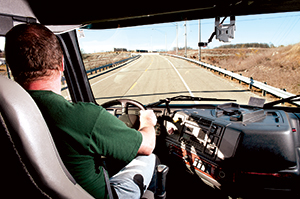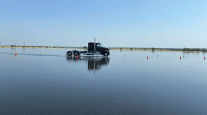Virginia Tech Receives Contract to Study Split Sleeper-Berth Time

Virginia Tech, along with subcontractors from Washington State University and technology vendor SmartDrive, has been awarded a $2.5 million contract from the Federal Motor Carrier Safety Administration to study a flexible hours-of-service safety provision that will allow longhaul truck drivers to split their required sleeper berth time into shorter periods.
The study will start later this year and is expected to conclude sometime in 2018.
Commercial truck drivers are currently required to log at least 10 hours off-duty before returning to on-duty status. Drivers using a sleeper berth must take at least eight of those hours consecutively.
FMCSA spokesman Duane DeBruyne said agency officials hope the Virginia Tech study will demonstrate how HOS regulatory flexibility, in conjunction with the agency’s Web-based educational and training Fatigue Management Program, can improve driver alertness.
“For some time now, sleeper-berth drivers have called for flexibility with the hours-of-service requirements, and this study will provide the scientific foundation for FMCSA to understand what the safety benefits and impacts may be in allowing such flexibility,” said Rich Hanowski, director of the Center for Truck and Bus Safety at the Virginia Tech Transportation Institute, which will conduct the three-year pilot program.
The school, officially the Virginia Polytechnic Institute and State University, is based in Blacksburg, Virginia.
American Trucking Associations and the Minnesota Trucking Association had petitioned FMCSA in 2013 to do such a study.
“We’re extremely pleased that FMCSA is going ahead, and we’re optimistic that the research will reveal what we already know to be true: that it’s more effective to drive when alert and rest while sleepy,” said Sean Garney, ATA’s director of safety policy. “It’s going to take them to get the data and to get it done right, which, of course, is something we want them to do. In past studies, maybe they haven’t gotten it quite so right because they didn’t collect the right data.”
The study is intended to include at least 200 longhaul truck drivers from large, medium and small carriers as well as owner-operators, who regularly use their sleeper berths. Garney said ATA will work with Virginia Tech to expand the pool of drivers to make sure it’s representative.
Kimberly Honn, a researcher from Washington State University, said drivers still will be required to comply with federal HOS safety requirements, but during the study, they will be allowed to use a “degree of flexibility” in logging sleeper berth time.
SmartDrive’s onboard video monitoring systems will collect data about driver behavior, including sleep patterns, sleepiness, roadside violations and crashes. Drivers will wear a monitor on their wrists.
“Keeping drivers and the motoring public safe is the top priority for our industry,” SmartDrive CEO Steve Mitgang said. “The onboard video monitoring system is uniquely capable of providing the insights required to understand the impact of flexible sleep schedules on driving.”
“Recruiting and retaining qualified drivers is a top issue for the Minnesota Trucking Association,” said its president, John Hausladen. “If driver sleeper-berth time can be split safely, which we hope the study confirms, it should improve the quality of life and create more flexibility. It would be a true win-win.”
Virgina Tech last year also led a congressionally directed Commercial Motor Vehicle Hours of Service restart study comparing work schedules over a period of five months and assessing such safety critical events as crashes, near-crashes and crash-relevant conflicts; operator fatigue and alertness; and short-term health outcomes among drivers operating under a one-night rest period versus drivers operating under a rest period with two or more nights. The drivers were recruited from small, medium and large fleets across a variety of operations.




